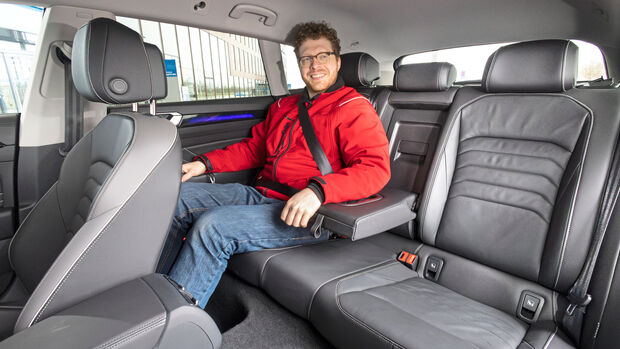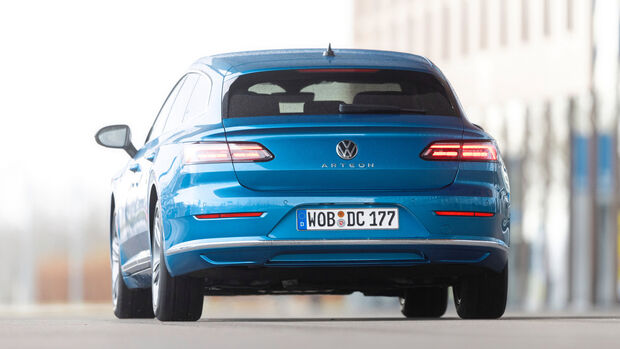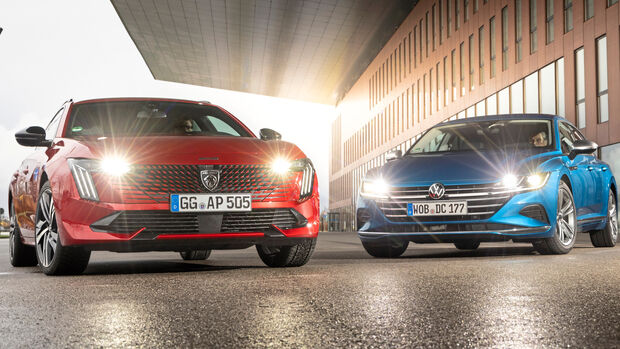You probably already know: Arteon will soon be discontinued without a successor. If you’re looking for a stylish station wagon or four-door coupe from Wolfsburg from this model year onwards, the new Passat B9 and fully electric ID.7 are still available. However, the Arteon Shooting Brake can still be ordered. And it should compete with the Peugeot 508 SW in our station wagon comparison.
As is known, the abbreviation SW in Peugeot stands for “Station Wagon”. In the past – at least since 1894 – Peugeot’s spacious models were simply called Break, at Volkswagen since 1961 they were called Variant. English fashion names may be more suitable for a combination of two designers.
Very safe Arteon passes through a two-way transition at a speed of 137 km / h. The 508 SW is more sedate and lags behind the Volkswagen at 129.4 km/h.
In any case, we have two very well-designed station wagons in front of us: the Peugeot 508 Station Wagon and the VW Arteon Shooting Brake. They look elegant and tall, both of them would be nicknamed “Shooting Brake”, even if only VW is called that. Coupé-like elements such as frameless side windows also emphasize that for both, look and feel are as important as the practical characteristics of a family station wagon.
Two copies of luggage
The loading areas of our designer station wagons show, among other things, that utility-oriented requirements were not at all important: a maximum volume of 1,780 liters (508) and 1,632 (Arteon) is evident. The Peugeot 508 SW proves to be the most practical station wagon in this comparison. It has a large loading opening, loads can be measured inside the car on an edge that is not very high (63 instead of 71 cm), and the backrests can be folded down using a remote release. Not very practical: apart from a small hatch, there is no real hatch. This will be best solved by using the Arteon Shooting Brake 2.0 TDI.
What’s really interesting, however, is that both station wagons are real models of cargo when it comes to loading: at 549 kg (VW) and 532 kg (Peugeot), they can transport more than ten hundredweight. Calculated differently: If four people weighing 75 kg each are on board, there is a generous 232 or 249 kg for cargo. Another feature of the Arteon’s impressive combination is the extremely flat loading area and the flat-mounted backrests.

The VW does not offer any space in the back and, with an interior length of less than one meter, it makes getting in more than a problem.
Both the candidates are not good when it comes to transporting passengers. Getting into the rear seats is difficult, and the interior height of less than one meter in the back is not generous either. In addition, the view of the outside world from the rear seats is quite limited.
The steering wheel is too small
You can feel more comfortable in the front seats. In fact, with the caveat that the Peugeot 508 is amazing because of the unique arrangement of the steering wheel and column as well as the wide center console – disappointing for a car that is almost 4.8 meters long.

Here you can already see that the steering wheel rim hides the view of the instruments.
The brand’s typical design with a very low steering wheel and an instrument display mounted above it forces the 508’s driver into an awkward and uncomfortable sitting position. The fact that operating it through both the screen, the switch bar and the steering wheel buttons is a difficult task does not make sitting in the Peugeot any more comfortable. In addition, its volume control is more intelligent and precise than that of the VW Arteon Shooting Brake 2.0 TDI. A clear advantage for the Wolfsburg of 4,866 millimeters in length, which at least the driver and front passenger can sit on generous-sized, comfortable and safe armrests and feel comfortable and airy.
The operation, however, is not so simple. While the key driving features are usually easier and more accurate to use than in the Peugeot, this does not apply to the use of infotainment or navigation. Of course, you get used to controlling, for example, the amount of information and the expansion of the map with various movements of shaking or swiping – two simple rotary controls would still be easier and more ergonomic. It is recommended, however, that the Arteon has a simple selector lever for automatic transmission, while the driver of the Peugeot 508 SW BlueHDi 130 has to work with a semi-automatic switch.
Twice with diesel
Which brings us to driving. An attentive reader will not have missed the fact that two designer suits have already met in a comparison test: two years ago they were needed as plug-in hybrids. This time both are being tested with diesel engines, although plug-in alternatives are still available.
Diesels prove to be a good choice. At least as long as you don’t have very high dynamic requirements. In particular, the 131 hp diesel engine in the Peugeot has a phlegmatic nature. It reacts only slowly to gas commands, but at least it cooperates well with its eight-speed torque converter transmission. And it uses slightly less fuel than the VW diesel (6.4 liters vs. 6.6 / 100 km). In fact, both can be run more economically than our test usage indicates. With a smooth accelerator pedal, an anticipatory driving style and avoid exciting steps, you can travel with no more than five liters of diesel per 100 km.

After 36.0 meters, the VW also… two meters later than the Peugeot.
VW is the most exciting touch in all aspects of life. Although he also raises the question of where the 150 hp and 360 Nm go. Because he is also not a very angry person. Of course, the two-liter diesel struggles against a weight of around 1.7 tons.
The 508 weighs almost three hundredths less – but this makes up for the lack of torque of the Peugeot engine. The 1.5-liter pushes a maximum of 300 Nm at the shaft. Excessive driving on country roads in the 508 needs to be addressed with foresight. Until the diesel engine and the automatic have found the right gear for the load and speed, the VW Arteon easily passes the barrier.
You can be satisfied with a top speed of more than 200 kilometers per hour in both vehicles. Here too, the Arteon is a little faster, without making any significant difference.
This difference is clearly visible when driving on country roads. The VW drives better, says colleague Sebastian Renz after a comparison drive through the frigid Löwenstein Mountains near Heilbronn. What he means by that: The Arteon leaves a balanced and balanced overall impression. It can be steered willingly and precisely even when driving at high speed, not least because it has a carefully programmed steering system that does not leave the driver in the dark about the destination. All of this works very well in the 508 SW. Which is mainly due to its operation. It turns out to be very smooth, with an almost fidgety driving behavior, but without significant precision or real feedback. That wouldn’t be so bad if another Peugeot chassis came with it.
The 508 brakes are even better
But the SW changes direction sluggishly and, with great understeer and early control, shows it doesn’t believe in cornering quickly. This results in a remote driving experience that allows you to participate a little in what is happening behind the wheel and in the engine room.
What the 508 can do well, however, is braking: when it comes to full braking at 100 km / h, it stops after 34.1 meters, a great value for a daily car. Despite its larger tires, the Arteon has an unexpected weakness: it only comes after 36 meters – a difference of almost two meters. It doesn’t sound like much, but on the road the VW would overtake the already stationary Peugeot at more than 20 km/h.
The chassis of Peugeot has no doubts about the velvet paws. It can compensate for larger imbalances well, but responds indifferently to subtle suggestions and leaves a noisy and uncomfortable impression. By the way, Peugeot only offers adaptive dampers for plug-in hybrids. VW does better with its DCC chassis (1,200 euros). It soaks up a lot of bumps better and looks a lot smoother and looser than the slightly stiffer Peugeot.

The weight difference between the light 508 SW and the heavier Arteon Bullet Brake is 143 kg.
Well, towards the end, you can’t help but talk a little about money. Not surprisingly, the VW Arteon Shooting Brake is the most expensive car. Not only is the list price high (53,445 euros), Volkswagen also – which is not very attractive – has high maintenance costs. And the Arteon Elegance’s standard equipment is leaner than the Peugeot’s. The 508 Allure SW, priced at 48,850 euros, includes, among other things, LED matrix lighting, a reversing camera or a full assistance package – all of these are additional features that are subject to additional charges for the Arteon.
For strict cost calculators, the Peugeot is not necessarily the second choice, even if the more expensive Volkswagen is the better car overall. You have to be prepared to afford a price difference of around 8,000 euros, adjusted for equipment, to the VW’s disadvantage.
The list price of both is a more theoretical value. The respective portal offers the 508 SW Blue-HDi 130 which can be configured at a discount of 26 percent while the Arteon Shooting Brake TDI with 150 hp is 22 percent. These diesels can save a lot of money, and not only on fuel.
| VW Arteon Shooting Brake 2.0 TDI Elegance | Peugeot 508 SW BlueHDi 130 Gravity | |
| Base price | 53.445 € | 49.800 € |
| External dimensions | 4866 x 1871 x 1451 mm | 4778 x 1859 x 1420 mm |
| Trunk volume | 565 to 1632 l | 530 to 1780 l |
| Transmission / engine | 1968 cm³ / 4-Cylinder | 1499 cm³ / 4-Cylinder |
| Performance | 110 kW / 150 HP at 3500 rpm | 96 kW / 131 HP at 3750 rpm |
| High speed | 216 km/h | 208 km/h |
| 0-100 km/h | 9, 6 ch | 11.2 s |
| consumption | 5.5 l/100 km | 5.2 l/100 km |
| Use of the test | 6.6 l/100 km | 6.4 l/100 km |

























